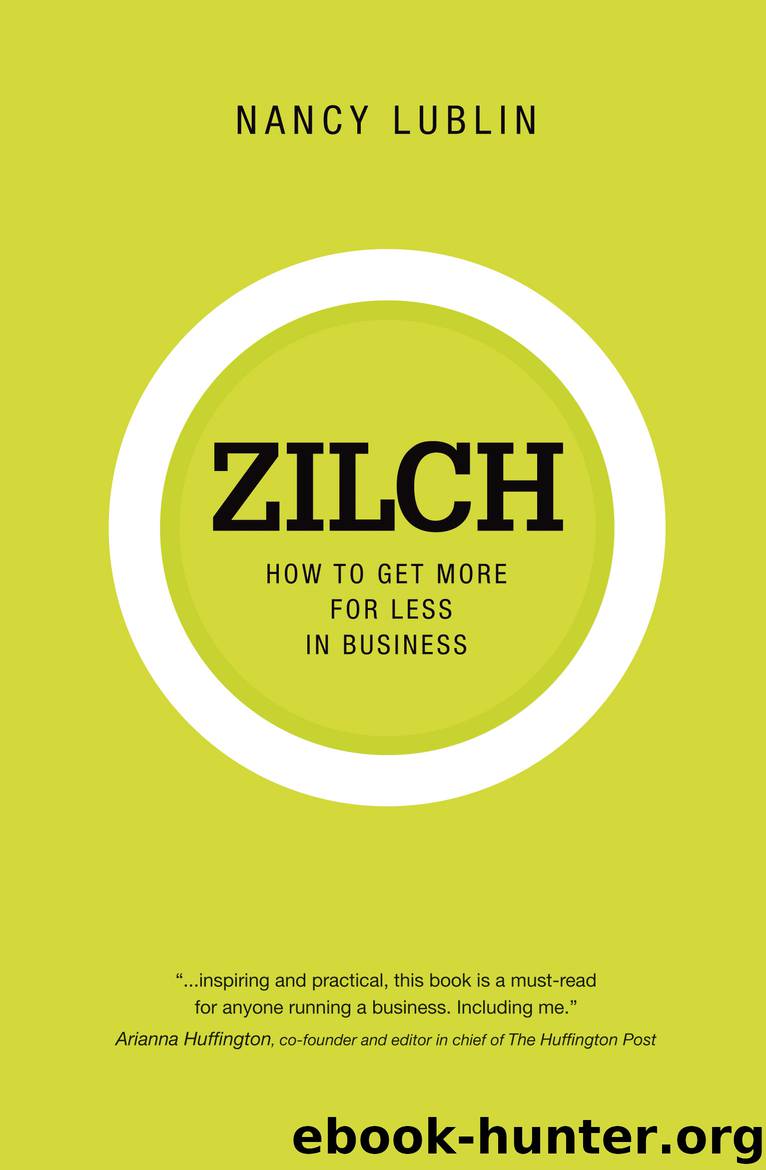Zilch by Nancy Lublin

Author:Nancy Lublin
Language: eng
Format: epub
Publisher: Bloomsbury Publishing
Published: 2011-04-12T04:00:00+00:00
ADJUST YOUR SELECTION CRITERIA.
The problems start when you’re looking for board members. At worst, corporations seek board members with the biggest names, the people who will impress shareholders, or the CEO’s golf buddies. The fancy firm you’ve hired to find good candidates wants to impress you with the stature of their list. The pool of candidates is often ridiculously, incestuously small. Take a quick flip through a pile of Fortune 500 annual reports. You’ll see a lot of retirees—former this and ex that. This is the corporate board as career pasture. CEOs tout their board members’ vast past experience, but how about current network? Are they connected to the latest trends in technology—or do they still refer to the Internet as the World Wide Web? Why do so few boards in the for-profit world have what many not-for-profits seek—people who are younger, more innovative, more primed for networking, hungrier?
As you peruse the group photos of corporate boards, you’ll also notice the tokenism and how the same faces repeatedly crop up to fill the de rigueur woman and minority slots. At a conference two years ago I heard Laura d’Andrea Tyson, the Clinton administration official who now teaches at UC–Berkeley’s Haas School of Business, speak about the “male and pale” syndrome that afflicts corporate boards. Tyson, who sits on the boards of Morgan Stanley, AT&T, and Eastman Kodak, is right. According to an article in Fortune, women occupy only one out of every six company directorships. Being that women make up half the population, that seems a bit disproportionate, no? Even companies that talk about diversity as a priority don’t apply that principle to their corporate board membership. Chrysler has an explicit corporate diversity policy, but its board is lagging. Some industry observers have described its board as “a male frat party at the Vatican” and “a white polar bear in an igloo.” To Tyson’s denotation of male and pale, I’d also add stale. Most of these board members are old!
The question is, how does this happen? One reason is basic human nature. We tend to gravitate to people who are like us, not just in race and age but in so many other ways, from schooling to career to club affiliations. Another reason is the homogeneity of the upper echelons of the corporate world—big companies want board members with extensive big-company experience and accomplishment, and these people tend to be older white males. To their credit, some companies are making a more active effort to select more diverse boards, just as corporate America is striving for more diverse management, but the progress is slow, as some still need to be convinced that it’s a valuable priority.
It’s not that I don’t like old white guys; it’s that I don’t think any kind of homogeneity is helpful. If the board is entirely young black women or middle-aged Greenwich Connecticuters or any other like-minded group, then the board will be limited in its ability to help the organization question, stretch, learn, grow, and succeed.
Download
This site does not store any files on its server. We only index and link to content provided by other sites. Please contact the content providers to delete copyright contents if any and email us, we'll remove relevant links or contents immediately.
Pioneering Portfolio Management by David F. Swensen(6079)
Man-made Catastrophes and Risk Information Concealment by Dmitry Chernov & Didier Sornette(5649)
Zero to One by Peter Thiel(5489)
The Motivation Myth by Jeff Haden(5003)
The Miracle Morning by Hal Elrod(4422)
Elon Musk by Ashlee Vance(3854)
The Art of Persistence: Stop Quitting, Ignore Shiny Objects and Climb Your Way to Success by Michal Stawicki(3572)
Unlabel: Selling You Without Selling Out by Marc Ecko(3470)
Delivering Happiness by Tony Hsieh(3283)
Urban Outlaw by Magnus Walker(3242)
Purple Cow by Seth Godin(3069)
Mastering Bitcoin: Programming the Open Blockchain by Andreas M. Antonopoulos(2891)
The Marketing Plan Handbook: Develop Big-Picture Marketing Plans for Pennies on the Dollar by Robert W. Bly(2795)
The Content Trap by Bharat Anand(2778)
The Power of Broke by Daymond John(2774)
Applied Empathy by Michael Ventura(2752)
The Airbnb Story by Leigh Gallagher(2700)
Keep Going by Austin Kleon(2597)
Radical Candor by Kim Scott(2579)
